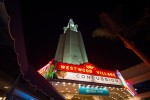As you look out onto the Westwood skyline, one building’s defining silhouette sticks out: a tall white tower topped with three neon red letters reading “FOX.”
Opened in the 1930s, the Regency Village Theatre and its across-the-street counterpart, the Regency Bruin Theatre, immediately became classic movie houses, serving both the student population and the affluent West Los Angeles area. Both are owned by Regency Theatres and only have one screening room each.
The Village Theatre seats a whopping 1,341 people and the Bruin Theatre seats 696 – making them prime spots for premiere-style events and a throwback to the original idea of cinema: that it’s an immersive experience shared among people sitting in the audience.
But around 80 years later, while the theaters’ structures are almost entirely unchanged, their community value has fallen into question.
Surrounding businesses have complained about the annoyance of premieres, and students have also criticized only having two films to choose from when looking to have a movie night in the Village.
In a time when audiences have grown accustomed to multiplex theaters that rapidly cycle through new movies, these complaints resonate with those looking for a theater shake-up in Westwood.
Yes, single-show theaters are uncommon, but that’s what makes them important and historic, especially in a location so vital to movie history as Westwood is. Take away the Regency theaters and you strip Westwood of its cinema charm – something students have undeniably benefited from.
Andrew Thomas, the executive director of the Westwood Village Improvement Association, said he’s glad the theaters are in Westwood.
“Westwood has a long history in the movie business, in entertainment – some of the biggest movies of all time have premiered here,” he said. “We’re fortunate to have two theaters that have (that) capacity … because there’s not many places where you can see a movie with (so many) people.”
But movie theaters have begun a battle against obsolescence, as their role of bringing new movies to the public is being replaced by online streaming competitors such as Netflix, Hulu and Amazon Prime Video. Westwood’s old-timey theaters only have a harder time given the Village is an entertainment desert.
This modern plight has created a challenge for theaters to stay profitable, especially ones like the single-show auditoriums in Westwood, said Jonathan Kuntz, a lecturer at UCLA’s School of Theater, Film and Television.
“Nowadays, a movie theater is just one place where we see a movie,” Kuntz said. “We see them in so many other venues and devices, so movie theaters are mainly showing things that have just come out and in fact, opening weekends are often (the most) crucial (aspect) to the success of the film.”
That premiere culture, it turns out, is what brings many students to Westwood’s screens in the first place. After all, the Village screens about 24 premieres yearly.
“When you’re in there, I feel like it’s a completely different experience than going to a multiplex,” said Lucky Shulman, a second-year design media arts student. “Those theaters are made for real movie premieres, which I feel like can’t be said for any other movie theater I’ve ever been to.”
Yet businesses adjacent to the theaters have expressed frustration about the theaters’ frequent movie premiere events. Store owners complain they lose business when the theaters block off Broxton and Le Conte avenues for their red-carpet events.
Merchants raised their concerns at the WVIA’s April 18 meeting, at which committee members agreed to create theater guidelines to address them. These proposed guidelines include providing advance notice of premieres, obtaining the signoff of business managers, limiting street closures and posting correct signage.
And we’ve all heard students complain about Westwood’s lack of movie options, given the theaters can only show a maximum of two movies at a time. It’s not unimaginable that some students would bring these criticisms to the North Westwood Neighborhood Council, whose current and prospective members have pledged to increase entertainment options in the Village.
This dichotomy between a unique cinema destination and a village that needs to keep up is something Westwood Village will have to reconcile in the coming years.
But we should keep this in mind: Movie theaters make little profit off actually selling tickets to their screenings, as most money spent on tickets goes back to the movie studios. This makes profitability for theaters a complicated process and an even more difficult one for single-show theaters. More movie screens in Westwood could result in the Village losing the high quality offered at the Regency theaters.
“They have made investments in the sound quality, … they’ve made investments in the visual experience, they’ve upgraded the projector systems,” Thomas said. “And a big part of that is because the premieres are demanding it.”
Of course, defending Westwood’s single-show theaters might seem like an attempt to resist modernization. But that argument overlooks how Westwood offers a movie experience that complements what many students already have: online streaming and movie theaters with many low-quality screening rooms.
Cinema is an art form meant to be viewed from a plush red seat in a movie theater surrounded by eager community members. Westwood has been offering that for nearly a century – and we shouldn’t pull the curtains on it.

These are great theaters and I hope they never go away. There used to be two or three other theaters in Westwood Village but they were shuttered well over a decade ago. Now there are only a handful of single-show theaters left in LA including the Vista in Los Feliz, the Nuart and Aero in Santa Monica and the Tarantino-owned New Beverly Cinema and Egyptian in Hollywood. We should do everything we can to protect this heritage.